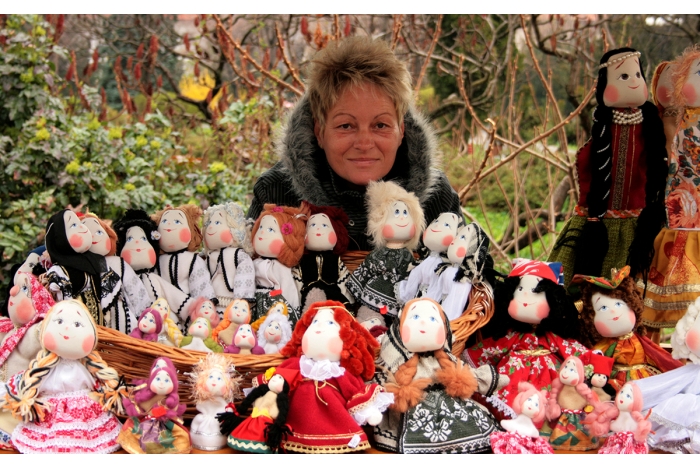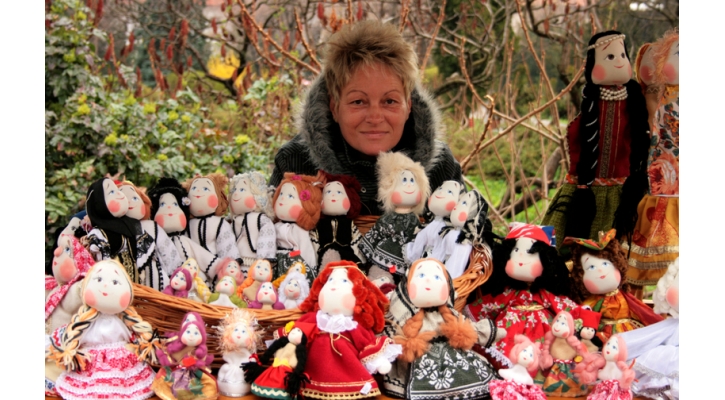Every Stitch Counts
A fundamental aspect that runs parallel of clothing traditions around the world is this: more often than not, for the pure love and joy of human expression, sentiment and creation.

Doina Nistor and her dolls. Photo by Ana A. Negru
Today, the recognition for the actual expertise, practice, patience and skills required to craft clothes (outside of the commercial fashion industry) is practically non-existent. Clothing today has lost nearly all attribution with its history and means in the long forgotten era of the hand crafted.
Clothes have become a commodity, manufactured and exported by large factories nation wide and shipped conveniently to a local shopping center. Where the materials in our clothes come from, how they are produced, how they got to be from a seed in the ground, to the cotton t-shirt found on the hanger in a store and alas on our backs; fails to ever comply with the average consumer concerns.
Furthermore, in contrast to today, the value of textiles used to lay as predominantly in the sentiment of each stitch, as it did as a whole. This almost extinct aspect yet once crucial avenue in production of hand made clothing, now long dormant in the heart of many human cultures, is thankfully still held vast to, and still exists, inside the practices of tradition. When examining a country ripe in traditions such as Romania, the making of clothing sits comfortably plump on the vine, in a cluster of traditional skills and craftsmen ships.
The making of much of the clothing in Romania stems from centuries of rural communities that employed simple machines and old procedures; boasting a prominent domestic textile industry that is developed thoroughly over time. Passed from one generation to another, knowledge and skill of this industry is a heartfelt gesture shared intimately between families and family members. However, in context, today this intimate gesture is struggling to survive.
Brasov local and current resident, Mrs. Doina Nistor recalls with a great fondness of the days of her childhood, spent inside the rural-countryside villages of her Grandparents, in the Teleorman and Transylvania regions of Romania. There, Doina could be found wide-eyed with curiosity amongst her female elders as they diligently and timelessly worked their traditional crafts (the making of costumes, bedding, draperies, and dolls).
Mrs. Nistor’s grandparents (as many did roughly four decades ago) pertinently, farmed, produced, and manufactured their textiles (of cotton, wool, or hemp, via spinning and looms) right at home. Her grandparents even worked raw silk, from their own silkworm farm (an inconceivable task to the average person today).
Mrs. Nistor’s most memorable moments from this time, come from Doina finding herself, perched quietly at the skirt helms of her grandmother, watching closely and carefully, as they craftily and intricately stitched traditional Romanian garments and dolls. During this time, these were created not for financial gain or profit but for the simple gifts of joy and happiness that they brought to their family members. “In Romania, every object and craft has the absolute love for the family at the foundation. (It is for no other reward than) To produce joy for a child, and for love.” explained Doina with sincerity, expressing “This is the essence of every Romanian craft. The Romanian craft is born from the love for the family, for God, for nature, and for everything (co-existing) in harmony.”
Significantly, in her impressionable youth filled years, Mrs. Nistor’s elders presented her with the ever-powerful gifts of tradition and hard work, by example.
As a result, today, Mrs. Nistor herself is now a special and timeless asset to the Brasov community, a shining beacon of example, and hope for the preservation of her profession and tradition. Six years ago Mrs. Nistor lead a relatively happy and stable life as a working engineer, however she couldn’t help but feel a lack of fulfillment and enjoyment in her day –to-day work. Not surprisingly to some, Mrs. Nistor found her self, nostalgic for the embedded love and joy of the simple rural traditions she experienced in her youth. Over the past few decades the commercialization and industrialization of Romania in urban centers, has diminished many of its rural communities, in tandem, diminishing the practices and simple ways of life Doina recalls. As such, Doina turned to and focused on, re-establishing the sharing of the traditional Romanian crafts of costume and doll making.
Mrs. Nistor hung her hat as an engineer and began to hand sew and craft traditional clothing and dolls here in Brasov, for sale and to showcase in local rural communities, events and exhibitions. Mrs. Nistor now works in partnership with other craftsmen in Romania and NGOs from abroad, to promote, maintain and instill these traditional practices before they are lost. Doina proudly creates costumes of meticulous high quality, for traditional dancers, and groups of youth. A well renowned and respected craftsman, Doina has even produced costumes for representation in New York, and held workshops for the likes of multinational companies.
Detail and respect lay at the forefront of Mrs. Doina’s craft. She posses a collection of books for learning and following the very specific customs and traditions of clothing making specific to each of Romania’s unique regions.
For every region has differentiating use and sentimenal symbolic meaning for certain textiles, symbols, and décor that they have forever used to comprise costumes that represent their nationality and community. More over, during the past century western and urban influences have crept into Romania’s rural areas, influencing changes that have in some cases, completely altered what the locals use as today’s ‘traditional’ costume in comparison to the past.
The Sacele community in Brasov, where Nistor predominantly works out of, is a prime example. The traditional costumes that represent Sacele today, are much more basic than in the past, dawning less symbols and embroidery. This is a direct result of the commercial growth and changes in the area. The faster pace of life today, and the demand for things to be done in a specific time frame, might be part of the reason a lot of the detail has been lost. It was “simple and such different times then,” tells Mrs. Nistor “Everything was different for a child then.
Everything was different, and fun. As a child I used to spend afternoons playing in the grass with the goats… I wish it were still that way today… (That lifestyle) is healthier for everybody. Each thing was made and done in its own time, with patience. Today everyone is in a hurry. When making a clothing or doll order, the very first question customers always ask me is, ‘ok, how much time?’"
Aside from Sacele, Mrs. Doina Nistor currently makes costumes for about seven different Romanian regions close to Transylvania, primarily in the Dragus and Fagaras areas. In context, Mrs. Nistor not only possesses the natural talent to hand create beautiful garments, but also the patience, hard work and perseverance that has established herself as a successful, independent entrepreneur, and a thriving repertoire as a respected clothing and doll maker. For those who may be interested in traditional clothing or dolls, they are welcome to visit Mrs. Nistor’s workshop in Sacele.
Text: Sky-Lee Jarrett
Photos: Ana A. Negru & Sky Lee Jarrett





